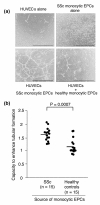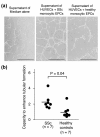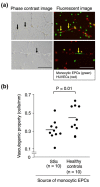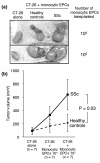Enhanced angiogenic potency of monocytic endothelial progenitor cells in patients with systemic sclerosis
- PMID: 21050433
- PMCID: PMC3046511
- DOI: 10.1186/ar3180
Enhanced angiogenic potency of monocytic endothelial progenitor cells in patients with systemic sclerosis
Abstract
Introduction: Microvasculopathy is one of the characteristic features in patients with systemic sclerosis (SSc), but underlying mechanisms still remain uncertain. In this study, we evaluated the potential involvement of monocytic endothelial progenitor cells (EPCs) in pathogenic processes of SSc vasculopathy, by determining their number and contribution to blood vessel formation through angiogenesis and vasculogenesis.
Methods: Monocytic EPCs were enriched and enumerated using a culture of peripheral blood mononuclear cells and platelets on fibronectin in 23 patients with SSc, 22 patients with rheumatoid arthritis (RA), and 21 healthy controls. To assess the capacity of monocytic EPCs to promote vascular formation and the contribution of vasculogenesis to this process, we used an in vitro co-culture system with human umbilical vein endothelial cells (HUVECs) on Matrigel® and an in vivo murine tumor neovascularization model.
Results: Monocytic EPCs were significantly increased in SSc patients than in RA patients or healthy controls (P = 0.01 for both comparisons). Monocytic EPCs derived from SSc patients promoted tubular formation in Matrigel® cultures more than those from healthy controls (P = 0.007). Transplantation of monocytic EPCs into immunodeficient mice resulted in promotion of tumor growth and blood vessel formation, and these properties were more prominent in SSc than healthy monocytic EPCs (P = 0.03 for both comparisons). In contrast, incorporation of SSc monocytic EPCs into the tubular structure was less efficient in vitro and in vivo, compared with healthy monocytic EPCs.
Conclusions: SSc patients have high numbers of aberrant circulating monocytic EPCs that exert enhanced angiogenesis but are impaired in vasculogenesis. However, these cells apparently cannot overcome the anti-angiogenic environment that characterizes SSc-affected tissues.
Figures








Similar articles
-
[Roles of aberrant endothelial progenitor cells in pathogenesis of systemic sclerosis].Nihon Rinsho Meneki Gakkai Kaishi. 2013;36(1):17-26. doi: 10.2177/jsci.36.17. Nihon Rinsho Meneki Gakkai Kaishi. 2013. PMID: 23445728 Review. Japanese.
-
Brief report: impaired in vivo neovascularization capacity of endothelial progenitor cells in patients with systemic sclerosis.Arthritis Rheumatol. 2014 May;66(5):1300-5. doi: 10.1002/art.38326. Arthritis Rheumatol. 2014. PMID: 24782187
-
Altered Properties of Endothelial Cells and Mesenchymal Stem Cells Underlying the Development of Scleroderma-like Vasculopathy in KLF5+/- ;Fli-1+/- Mice.Arthritis Rheumatol. 2020 Dec;72(12):2136-2146. doi: 10.1002/art.41423. Epub 2020 Oct 30. Arthritis Rheumatol. 2020. PMID: 32627966 Free PMC article.
-
Proangiogenic hematopoietic cells of monocytic origin: roles in vascular regeneration and pathogenic processes of systemic sclerosis.Histol Histopathol. 2013 Feb;28(2):175-83. doi: 10.14670/HH-28.175. Histol Histopathol. 2013. PMID: 23275301 Review.
-
Bone marrow endothelial progenitors are defective in systemic sclerosis.Arthritis Rheum. 2006 Aug;54(8):2605-15. doi: 10.1002/art.22035. Arthritis Rheum. 2006. PMID: 16868984
Cited by
-
Monocytes and Macrophages in Cancer: Unsuspected Roles.Adv Exp Med Biol. 2020;1219:161-185. doi: 10.1007/978-3-030-34025-4_9. Adv Exp Med Biol. 2020. PMID: 32130699 Review.
-
Platelet-derived stromal cell-derived factor-1 is required for the transformation of circulating monocytes into multipotential cells.PLoS One. 2013 Sep 16;8(9):e74246. doi: 10.1371/journal.pone.0074246. eCollection 2013. PLoS One. 2013. PMID: 24066125 Free PMC article.
-
The Potential Role of Trained Immunity in Autoimmune and Autoinflammatory Disorders.Front Immunol. 2018 Feb 20;9:298. doi: 10.3389/fimmu.2018.00298. eCollection 2018. Front Immunol. 2018. PMID: 29515591 Free PMC article. Review.
-
Fos-related antigen-1 transgenic mouse as a model for systemic sclerosis: A potential role of M2 polarization.J Scleroderma Relat Disord. 2019 Jun;4(2):137-148. doi: 10.1177/2397198319838140. Epub 2019 May 19. J Scleroderma Relat Disord. 2019. PMID: 35382387 Free PMC article.
-
Vasculopathy in scleroderma.Semin Immunopathol. 2015 Sep;37(5):489-500. doi: 10.1007/s00281-015-0505-5. Epub 2015 Jul 8. Semin Immunopathol. 2015. PMID: 26152638 Review.
References
Publication types
MeSH terms
LinkOut - more resources
Full Text Sources
Medical

